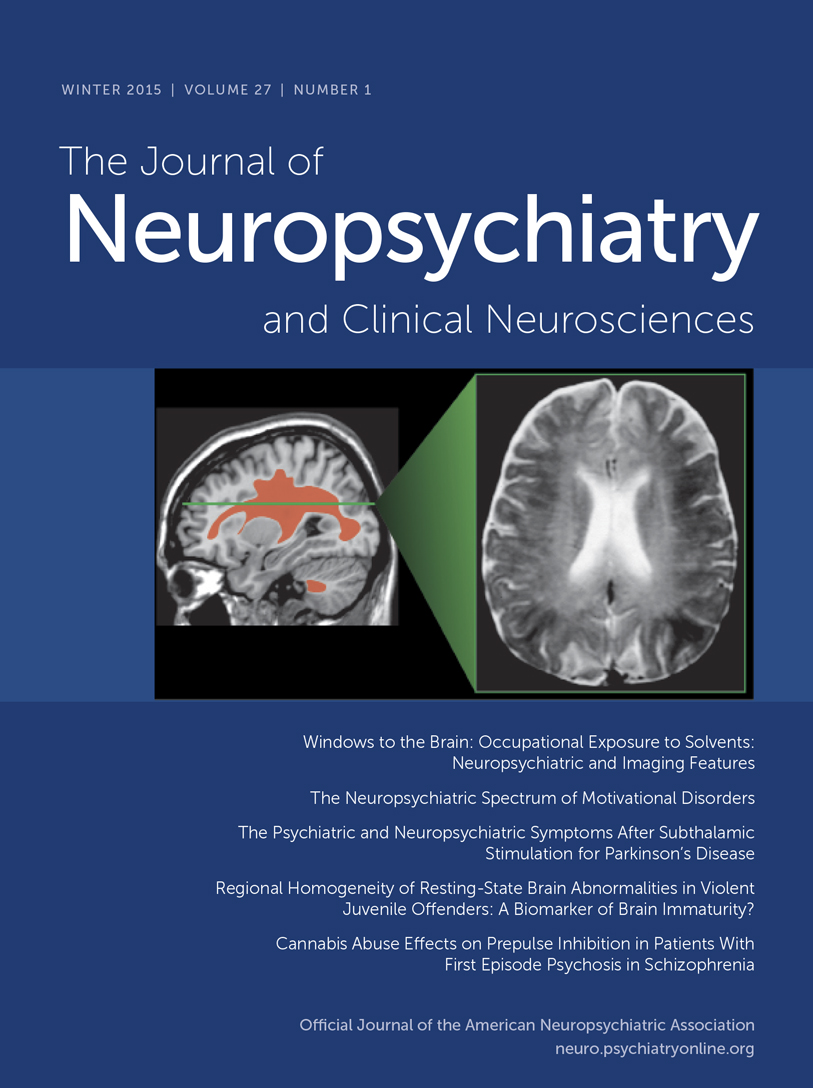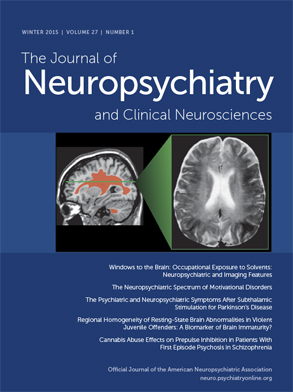Premorbid cognitive impairment is a risk factor for delirium. Because vitamin D deficiency has been associated with cognitive impairment, hypovitaminosis D may be a plausible relative risk factor for the development of delirium.
1,2 In animal and human studies, vitamin D, a secosteroid hormone in its active metabolite form that binds to vitamin D receptors, has been linked to numerous cerebral processes including neuroprotection.
3 Masoumi et al.
4 demonstrated that 1,25-dihydroxyvitamin D (the active form of vitamin D) strongly stimulated β-amyloid phagocytosis and subsequent clearance providing protection against cellular apoptosis, known to be important in the pathogenesis of Alzheimer's disease. Vitamin D promotes neuroprotection by modulating the production of choline acetyltransferase, the key enzyme in the biosynthesis of acetylcholine.
5 Because cholinergic deficits are implicated in delirium, hypovitaminosis D has been speculated to play a role in developing delirium.
1,6Vitamin D has been experimentally linked to both antineurodegenerative and anti-ischemic effects. Ischemic infarcts and white matter hyperintensities have been associated with hypovitaminosis D.
7 Using data from the Nutrition, Aging, and Memory in Elders study,
8 Buell et al.
9 found an inverse association between vitamin D levels and the presence of white matter hyperintensities and large vessel infarcts. Vitamin D levels were also found to be inversely associated with neuroimaging evidence of multiple sclerosis activity.
10 A review by Annweiler et al.
11 revealed reports of ischemic infarcts and white matter hypertintensities in hypovitaminosis D. This, combined with the reported findings of executive dysfunction in hypovitaminosis D, led to their proposal that hypovitaminosis D may be associated with dysfunction of frontal-subcortical circuits,
11 which may be of significance in delirium. Despite the theoretical basis for a link between vitamin D and delirium, to date there has been only a limited exploration of this association.
12 We explored the frequency of cortical atrophy and/or cerebrovascular disease in patients with delirium with hypovitaminosis D and those with normal range vitamin D levels.
Methods
We conducted a retrospective cross-sectional study of inpatients at three academic medical centers in Hamilton, Ontario, Canada, by extracting electronic data systematically from medical records, which used ICD-10.
13 This study was approved by McMaster University's institutional ethics review board. Eligible cases were defined as any medical or surgical inpatient 18 years of age or older who received a discharge diagnosis of delirium between January 1, 2011 and July 31, 2012, who had a serum 25-hydroxyvitamin D test and had neuroimaging performed. Serum total calcium, magnesium, phosphate, and intact parathyroid hormone values were also extracted. Local laboratory reference values were used for suboptimal vitamin D (or hypovitaminosis D), defined as a 25-hydroxyvitamin D level < 75 nmol/L, and optimal (or sufficient) vitamin D, defined as a 25-hydroxyvitamin D level ≥ 75 nmol/L. Diagnoses of dementia for these cases were also extracted from the database. Neuroimaging findings were classified as (1) vascular disease consisting of micro- and macro-angiopathic changes, (2) cortical atrophy, or (3) mixed, with vascular disease and cortical atrophy. Analyses compared subjects with hypovitaminosis D to those with sufficient vitamin D levels and associated neuroimaging findings. Descriptive analyses generating means and standard error of the mean for continuous data and proportions for categorical data were conducted. Statistical analyses were performed using SAS version 9.2 (SAS Institute, Cary, NC), and p<0.05 was the level of significance.
Results
Table 1 contains demographic and laboratory characteristics of the study group. A total of 51 of 1232 patients with delirium had all the characteristics and were included in the study. Of those, 35 patients (68.6%) showed hypovitaminosis D, and 16 showed sufficient vitamin D levels. Mean age was 78.5±1.8 years. In the hypovitaminosis D group, cerebral vasculopathy and/or atrophy on neuroimaging was found in 32 patients: eight patients with vascular disease, seven patients with cortical atrophy, and 17 patients with cortical atrophy plus vascular disease, whereas the sufficient vitamin D group (N=13) included four patients with vascular disease, one patient with cortical atrophy, and eight patients with cortical atrophy plus vascular disease. A total of six patients (three patients in each comparison group) had either no CT scan findings or other CT scan findings. A comorbid dementia diagnosis was found in five of 32 (15.6%) patients with hypovitaminosis D and three of 13 (23.1%) in those with sufficient vitamin D (
Table 1). The differences in frequency of CT scan abnormalities and frequency of dementia diagnosis were not significant between the hypovitaminosis D and normal range vitamin D groups. There were no significant differences in vitamin D levels found by category (i.e., vascular, atrophy, or mixed) of head CT scan findings. Analysis of covariance (ANCOVA) revealed higher levels of serum total calcium in the atrophy neuroimaging group compared with either vascular or mixed groups while controlling for age, which was a finding of uncertain significance.
Discussion
More than 90% of patients with delirium with hypovitaminosis D exhibited neuroanatomic vascular and/or cortical atrophy abnormality on CT scan findings in this retrospective sample. The frequency of these neuroimaging findings in patients with delirium with hypovitaminosis D was not significantly different from those of patients with delirium with a normal range vitamin D.
Numerous brain dysfunctions have been linked to vitamin D deficits and/or dysfunction of its vitamin D receptor,
3 although causality has not yet been determined. Because the role of vitamin D on brain function has become more explicit, clinicians and researchers have speculated that hypovitaminosis D may play an important role in the pathogenesis of neurocognitive dysfunction.
14 However, a recent study found no association between hypovitaminosis D and cognitive function as represented by Mini-Mental State Examination scores.
15Notably, the majority of patients with hypovitaminosis D who had head CT scans (N=32; 91.4%) showed cerebrovascular and/or cortical atrophy abnormalities, but only five of 32 (15.6%) of those included in the sample had a comorbidly diagnosed dementia, suggesting that many delirium cases with positive CT scans do not have a formal dementia diagnosis established before the delirium episode. The finding of 91.4% of delirium cases with hypovitaminosis D and abnormal cortical atrophy and/or cerebrovascular findings is striking and suggests that such CT scan findings may correlate with a tendency toward “delirium proneness” not necessarily requiring clinical cognitive impairment sufficient to render a clinical diagnosis of dementia separate from the delirium diagnosis. Whether there is possibility of predementia mild cognitive impariment requires further investigation. Despite previously reported studies of ischemic and white matter changes in the brains of individuals with hypovitaminosis D,
7,11 in our study population, there was no effect of vitamin D status on any type of vascular and/or cortical CT scan abnormality, thus failing to demonstrate an effect of vitamin D status per se on these findings.
This study is limited by the relatively small sample size in both the normal and hypovitamin D groups and hence had a limited power to detect neuroimaging and vitamin D status differences. Furthermore, all factors known to contribute to hypovitaminosis D could not be included in our model due to the availability of information in our data repository (e.g., environmental factors, nutritional status, race, hemodynamics, medications and supplements, and restricted hospital settings). Further neuroimaging studies are therefore needed to determine whether hypovitaminosis D and neurodegenerative and/or cerebrovascular lesions may contribute to delirium.
This was a naturalistic, retrospective study accomplished based on data generated from delirium cases managed in academic medical centers. At these centers, there is no standardized order set or common clinical pathway for the medical management of delirium. Some physicians caring for delirium patients at these medical centers order studies of calcium, phosphorus, and vitamin D based on the clinical presentation of the delirium patients in search of modifiable variables. Because we studied only those delirium patients with data about vitamin D status, we cannot systematically compare those cases who had these studies obtained to the other delirium cases on whom such studies were not obtained. Ideally, in a larger study with a prospective design, one would seek to standardize laboratory assessments to avoid possibly confounders that may obscure results.
Classification of CT scan results as vascular disease, atrophy, and mixed vascular/atrophy were made on the basis of routine neuroradiology interpretation. Our data were extracted directly from the neuroradiological reports and presented as seen in
Table 1. As such, it is not possible to a priori establish parameters for interrater reliability, standardization of imaging protocols, and other aspects of the neuroimaging methodology, which would be clearly desirable in a prospective design wherein such technical details could perhaps be more rigorously standardized, thus minimizing the possibility of sources of interrater error.

